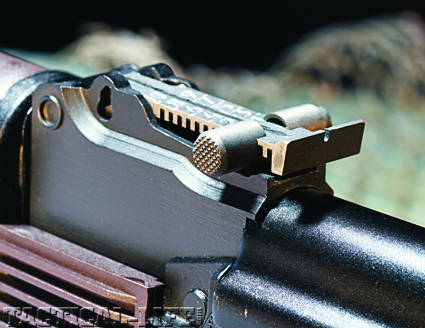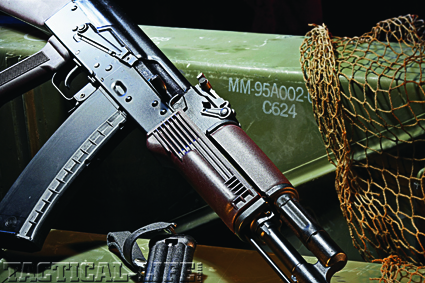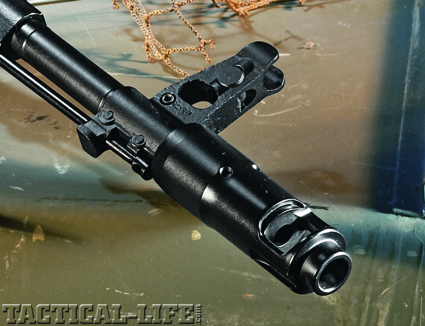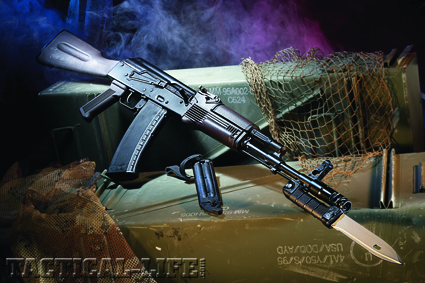The Kalashnikov has been, from its beginnings in the late 1940s on to its use in today’s post-Cold War Russian Federation, something of an evolutionary revolutionary. Although the basic premise of the AK-47 was radically advanced in its day—namely being an intermediate cartridge-based “assault rifle” developed from the hard-earned knowledge gained in the urban combat of World War II—the design has been updated over the decades to keep it as cutting-edge as possible.
While the AK-47’s design approach may have been revolutionary, its production methods have always been somewhat dated. Originally designed to feature a stamped-steel receiver, early AKs actually employed milled steel receivers because of complications that arose with those first stamped versions. In addition, the rifles employed wooden stock sets.
Despite its somewhat traditional construction the AK was far advanced compared to many of its contemporaries. With its 7.62x39mm cartridge and detachable 30-round magazine, the AK offered the rate of fire of a sub-machine gun combined with the power of a rifle.
Advertisement — Continue Reading Below
Nonetheless, by the late 1950s the Soviets recognized that the basic AK platform could use some modernization. The resulting adaptation, known as the AKM (with the M standing for modernized or modernizirovany), employed a newly designed stamped-steel receiver that reduced both weight and production costs, and a laminated stock set that was stronger and more resistant to harsh environments than traditional wood. Other changes included a ribbed top cover that was thinner and lighter and a slant muzzle brake.
A New Standard
Although the new AKM brought the Kalashnikov design forward in both its composition and construction, and it still compared quite favorably against the arms of the day, the West was about to raise the stakes with a radically new military rifle—the M16.
Adopted by the US military in the early 1960s, the M16 set new standards in construction, operation and ballistic capabilities. Whereas the Soviets had wholeheartedly embraced the intermediate cartridge concept with its 7.62x39mm immediately following WWII, the West and NATO (at the urging of the United States) initially stayed with a more traditional-style rifle cartridge in its 7.62x51mm (.308).
Advertisement — Continue Reading Below
However, with the adoption of the M16, the West moved in a radically new cartridge design direction with the 5.56x45mm (.223). Propelling a roughly 50- to 60-grain projectile at around 3,200 fps (feet per second), the light-recoiling 5.56x45mm cartridge represented the next step in intermediate cartridge design—and arguably a step beyond the Soviet 7.62x39mm.
The upper echelons of the Soviet Defense Industry looked very closely at the new 5.56x45mm cartridge and determined that the standardized Soviet 7.62x39mm cartridge deserved a second look, as well as the AK platform itself. The result, introduced in 1974, was the AK-74, an adaptation of the AKM chambered for the new 5.45x39mm cartridge.
The 5.45x39mm stacked up favorably against the West’s 5.56x45mm, propelling a lightweight 50- to 60-grain bullet at around 3,100 fps. In addition, it featured a similar overall length to the 7.62x39mm, meaning that the basic AKM platform could be modified to fire it.
Advertisement — Continue Reading Below
The new AK-74 rifle that resulted was a relatively understated adaptation of the AKM. Featuring a laminated stock set and a stamped steel receiver, the 74 had a longitudinal cut in the sides of the buttstock, composite magazines with a restrained orange hue and a highly effective muzzle device.
Although the AK-74 was a highly capable arm and a logical next step in the evolution of the AK-pattern rifle, its construction and manufacture was still dated when compared against the new M16 with its use of advanced alloys and composites.
In the late 1980s, combat experiences gained in Afghanistan resulted in the Izhmash Arms Factory, a Soviet armory that produced Kalashnikovs, taking another look at the AK-74 platform. The goal was to create a modernized version that updated the materials, construction and configuration of the rifle.
First and foremost, it was decided that the stock sets of the 74 should be made from modern synthetics that would hold up better and be lighter than the laminated wood previously used. In addition, the composite magazines of the 74, which had a dull orange hue, had proven to reflect both sunlight and moonlight. As a result, new magazines were produced from black plastic. To facilitate the use of optics and night vision equipment, a universal mounting rail was developed that was affixed to the left side of the receiver.
Advertisement — Continue Reading Below
The series of rifles that resulted represented a notable evolutionary step up from the basic AK-74, ultimately embodied by the new AK-74N variant that featured cutting-edge design and materials.

Gun Details
Unfortunately, Russian semi-automatic variants of this style of rifle have been, for all intents and purposes, very difficult to acquire in this country due to a variety of political and legal restrictions. But, thanks to the efforts of Las Vegas-based Arsenal Inc., a true Russian civilian-legal variant of the 5.45x39mm AK-74N is available here in the United States as the SGL31.
Advertisement — Continue Reading Below
Arsenal, known for its line of high-quality Bulgarian-style Kalashnikovs, developed the SGL31 as part of joint project with Legion Ltd., the custom shop of the famed Izhmash Arms Factory in Russia. Izhmash is one of Russia’s oldest armsmakers with a history dating back to the early 1800s when Tsar Alexander I founded it.
Legion, which had been looking to gain more of a presence in the United States market, jumped at the chance to work with Arsenal on this project as it recognized that the company would uphold the high quality standards of the original rifles. Working with the custom shop of this famous manufacturer, Arsenal has managed to bring an extremely unique product to market—namely a Russian AK-74N-style rifle with all the modern amenities and the quality and attention to detail for which both groups are known.
So how is the SGL31 produced? Arsenal imports sporterized Kalashnikov variants known as Saiga rifles from Legion. These Saigas feature a conventional-style stock with the triggerguard and firing group moved rearward with the vertical pistol grip removed. Also, the magazine well is incapable of accepting traditional high-capacity magazines.
Advertisement — Continue Reading Below
Once Arsenal receives the rifles, they set about modifying them from their “sporterized” configuration. The process involves Arsenal installing a proscribed number of its own high-quality US-made parts for legality. In addition to the added parts, the imported Saigas require heavy modification to be reconfigured to a military-style configuration. This involves the triggerguard and firing group being relocated to their proper positions so a military-style pistol grip can be employed, as well as the magazine well being modified to accept high-capacity magazines.
The SGL31, which is the follow-up to Arsenal’s earlier SGL21 rifle in 7.62x39mm produced with Legion, offers the American shooter a chance to own a rifle that is extremely close to a true Russian AK-74N in semi-automatic-only form, of course.
The stamped-receiver SGL31 features all the enhancements and upgrades of the most current AK-74 variants, such as a modern polymer stock set with a longitudinal groove in the buttstock and a correct ribbed steel buttplate, a highly effective muzzle brake, optics rail and a 90-degree gas block to name just a few.
Advertisement — Continue Reading Below
In addition to the obvious qualities of the rifle, namely high quality and attention to detail, the SGL31’s similarity to a true AK-74N should make it particularly appealing to AK enthusiasts and collectors. In particular, the SGL31 features the famous Izhmash logo, an upward pointing arrow that has adorned numerous Soviet arms, and very few commercial markings.
The SGL31’s receiver also sports correct “X” and “Y” reinforcement stampings on the hammer and trigger pinholes as well as the proper dimples above the magazine well opening and correct notch positions for the safety lever. To ensure reliable functioning, a proper bullet guide designed for double-stack magazines is located inside the receiver.

Advertisement — Continue Reading Below
Hands On
I recently had an opportunity to test and evaluate one of these fine rifles for myself. Priced at a very reasonable $799 retail, the SGL31 Standard rifle is available with a black, an olive drab green or a plum stock set. I opted for the plum-stocked variant.
The rifle came packed in a cardboard box, packed with a single 10-round Russian magazine. I requested some optional 30-round Bulgarian magazines to really put the rifle through its paces, which Arsenal included with my test rifle.
The fit and finish of the rifle was superb. All steel parts featured a deep black enamel coating, and the US-made stock set had a rich dark plum color with an attractive matte tone and a stainless steel heat shield in the lower handguard. The magazine well was cleanly cut, and the magazines seated and removed easily and positively. The large safety lever clicked on and off positively and was easy to operate.
Sights of the SGL31 are traditional Kalashnikov-style sights. The rear unit is a sliding tangent notch with markings out to 1,000 meters, while the front is a winged post adjustable for windage and elevation. Topping off the muzzle on 24×1.5 right-hand threads was an Arsenal-produced AK-74-style muzzle brake, retained by a spring-loaded plunger pin. Also of note is the fact that the rifle features an accessory lug on the front sight base that allows it to accept a bayonet.
Under the barrel was a cleaning rod, while the buttplate on the buttstock sported a spring-loaded trapdoor to allow access to a compartment for a standard AK cleaning kit. On the left side of the rifle’s receiver was the optics rail.

Range Time
For testing, I took the SGL31 out to the range with some Wolf 60-grain FMJ ammunition and put it through its paces. Although the SGL31 did have an optics rail, I did not have any optical mounts that could interface with it on hand. As a result, the accuracy testing at 100 yards was done with the standard iron sights.
Operation of the SGL31 should be familiar to anyone who has used a Kalashnikov-style rifle. Magazines are rocked in and held by a paddle-style release in front of the triggerguard. A large dustcover/safety lever is located on the upper right side of the receiver, being swept down to take the rifle off “safe.”
During the course of testing with several hundred rounds, there was not a single malfunction. The two-stage trigger of the SGL31 was reasonably clean breaking without the unpleasant “trigger slap.” It broke at around 8.5 pounds. Accuracy proved to be good considering the design and intended purpose of the rifle with one really impressive group measuring just over 2.5 inches.
I noted during testing that the AK-74-style muzzle brake was quite effective at taming perceived recoil, making the SGL31 a pleasure to shoot. Also, the stainless steel heat shield in the handguard did a good job of dissipating barrel heat and keeping the support hand comfortable during extended firing sessions.
Final Notes
For those like me who greatly appreciate Soviet-era and Russian arms, the SGL31 from Arsenal should prove to be very hard to resist. Offering an excellent example of late-era Soviet weapons design at an extremely reasonable price, the SGL31 should definitely be a part of any AK fan’s collection. For more information, contact: Arsenal Inc., 702-643-2220; arsenalinc.com.






















